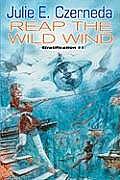
| Series: | Stratification #1 |
| Publisher: | DAW |
| Copyright: | 2007 |
| Printing: | September 2008 |
| ISBN: | 0-7564-0487-8 |
| Format: | Mass market |
| Pages: | 459 |
Reap the Wild Wind is the first book in the Stratification series. This is set in the same universe as the Trade Pact series (which starts with A Thousand Words for Stranger), but goes back in time, telling the story of the Om'ray before they left Cersi to become the Clan. You may have more interest in this series if you read and enjoyed the Trade Pact trilogy, but it's not a prerequisite. It's been over ten years since I read that series, I've forgotten nearly everything about it except the weird gender roles, and I didn't have any trouble following the story.
Aryl Sarc is member of the Yena Clan, who live a precarious existence in the trees above a vast swamp filled with swarms of carnivorous creatures. They are one of several isolated clans of Om'ray on the planet Cersi. Everything about the clans is tightly constrained by an agreement between the Om'ray, the Tiktik, and the Oud to maintain a wary peace. The agreement calls for nothing about the nature of the world or its three species to ever change.
Reap the Wild Wind opens with the annual dresel harvest: every fall, a great, dry wind called the M'hir flows down the mountains and across the forest in which the Yena live, blowing free the ripe dresel for collection at the treetops. Dresel is so deeply a part of Aryl's world that the book never explains it, but the reader can intuit that it contains some essential nutrient without which all the Yena would die. But disaster strikes while Aryl is watching the dresel harvest, disaster in the form of a strange flying vehicle no one has seen before and an explosion that kills many of the Yena and ruins the harvest essential to life.
The early part of the book is the emotional and political fallout of this disaster. Aryl discovers an unknown new talent, saving the man she's in love with (although they're too young to psychically join in the way of the Om'ray) at the cost of her brother. There's a lot of angst, a lot of cliched descriptions of internal psychic chaos (the M'hir that will be familiar to readers of the Trade Pact books), and a lot of her mother being nasty and abusive in ways that Aryl doesn't recognize as abuse. I struggled to get into the story; Aryl was an aimless mess, and none of the other characters were appealing. The saving grace for me in the early going were the interludes with Enris, an Om'ray from a far different clan, a metalworker whose primary dealings are with the Oud instead of the Tiktik.
This stage of the story thankfully doesn't last. Aryl eventually ends up among the Tiktik, struggling to understand their far different perspective on the world, and then meets the visitors who caused the disaster. They're not only from outside of Aryl's limited experience; they shouldn't even exist by the rules of Aryl's world. As Aryl slowly tries to understand what they're doing, the scope of the story expands, with hints that Aryl's world is far more complicated than she realized.
Czerneda sticks with a tight viewpoint focus on Aryl and Enris. That's frustrating when Aryl is uninterested in, or cannot understand, key pieces of the larger picture that the reader wants to know. But it creates a sense of slow discovery from an alien viewpoint that occasionally reminded me of Rosemary Kirstein's Steerswoman series. Steerswoman is much better, but it's much better than almost everything, and Aryl's growing understanding of her world is still fun. I particularly liked how Aryl's psychic species defines the world by the sensed locations of the Om'ray clans, making it extremely hard for her to understand geography in the traditional sense.
I was also happy to see Czerneda undermine the strict sexual dimorphism of Clan society a tiny bit with an Om'ray who doesn't want to participate in the pair-bonding of Choosing. She painted herself into a corner with the extreme gender roles in the Trade Pact series and there's still a lot of that here, but at least a few questions raised about that structure.
Reap the Wild Wind is all setup with little payoff. By the end of the book, we still just have hints of the history of Cersi, the goals of the Oud or Tiktik, or the true shape of what the visitors are investigating. But it had grabbed my interest, mostly because of Aryl's consistent, thoughtful curiosity. I wish this first book had gotten into the interesting meat of the story faster and had gotten farther, but this is good enough that I'll probably keep reading.
Followed by Riders of the Storm.
Reviewed: 2018-01-29